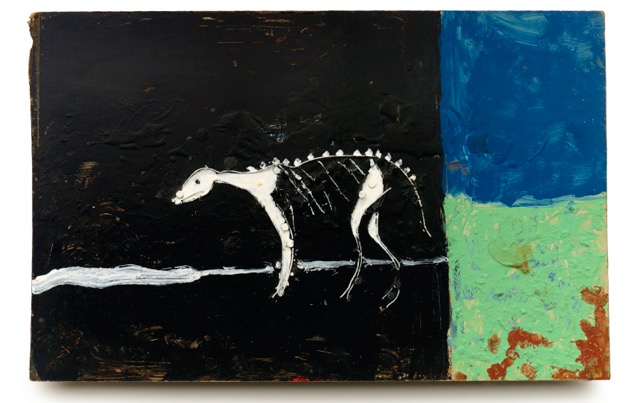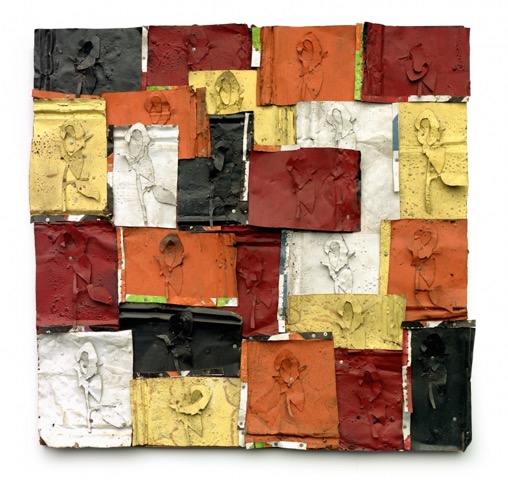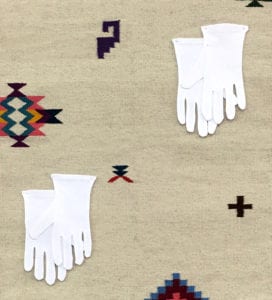Tomorrow evening, Young Folk, the young patrons arm of the American Folk Art Museum will host its first panel on the art and legacy of Ronald Lockett. Organized by Emily Counihan and Donnamarie Baptiste, “Speaking of Gold and Rust” will bring together contemporary artists and arts professionals for a candid discussion of themes in their work and Lockett’s. We caught up with Emily and Donnamarie to get the scoop on the panel and why the life of Ronald Lockett is so important within today’s art and society.

Art Zealous: How do you know each other?
Emily: We first met in Miami through a mutual friend and art collector. Donnamarie was working with Art Basel at that time, and I was Director of the Outsider Art Fair. We talked about our mutual passion for art including self-taught art and became fast friends.
Donnamarie: I think we met in 2010 or was it 2011? It was really refreshing to meet someone who loved contemporary art, but also appreciated and respected self-taught art and artists as much as I do. We’ve been close ever since.
AZ: What do you do?
Emily: VIP Relations Manager at New Art Dealers Alliance.
Donnamarie: I’m an Arts Director and Producer, currently working with emerging and mid-career artists on film projects, including the launch of a Caribbean Film Festival in the U.S this fall.
AZ: How did you become involved with the American Folk Art Museum?
Emily: In 2007 I began working for a gallery where the program was focused on work by self-taught artists. I was coming from a contemporary art background and wanted to learn more about self-taught art. At the suggestion of the gallery owners, the wonderful collectors George and Sue Viener, I took a class at AFAM where I first learned of Martín Ramírez, Thornton Dial, and many other artists. Learning about this great work significantly expanded my understanding of modern and contemporary art. I became a member of AFAM and continued to be involved professionally in my role at the Outsider Art Fair. When I was invited to join Young Folk upon its launch in 2014, I was excited about the opportunity to be part of this dynamic and innovative group. I have met some of the most amazing people through Young Folk and shared many great memories.
Donnamarie: Through Emily! Although I had been working in the contemporary art world, my passion for self-taught art stems from my Caribbean roots and from living in the U.S. South. While living and traveling in both locations, I met some of the most talented artists I’ve ever known and seen the some of the most amazing works. I figured AFAM would be a great place to see some of those kinds of works in NYC, and was interested in learning more about AFAM once Emily told me about her involvement.
AZ: Why are you putting on this panel?
Emily & Donnamarie: We thought it would be great for Young Folk to sponsor a panel around this exhibition because Ronald Lockett represents a younger generation of African-American self-taught artists from the South. Lockett worked closely with Thornton Dial, for example, and added a contemporary perspective to the distinct artistic language Dial and other artists in the older generation forged. We wanted to bring in artists and art professionals with diverse experiences to delve into the work and celebrate it in a way that could open the conversation to new audiences.
AZ: Why is the title of the panel Speaking of Gold and Rust?
Emily & Donnamarie: The title is somewhat poetic in that gold represents a symbolic subsuming of rust. The rusty metal Lockett used in so much of his work contains references to physical destruction and frailty. But as in the title of one of Lockett’s works (and exhibition curated by Valérie Rousseau) Once Something Has Lived It Can Never Really Die, the value and meaning of his art remains vital and untarnished.
AZ: Why is “Fever Within: The Art of Ronald Lockett” a must-see exhibit?
Emily: This is the first major museum exhibition of Lockett’s work.
Donnamarie: It’s important because it not only gives Ronald Lockett’s work the recognition it deserves but hopefully introduces art lovers and collectors to the brilliance of younger self-taught artists. We believe adamantly that these artists should be part of the contemporary conversation. Our hope is that self-taught artists become appreciated as much when they are alive as when they are no longer with us.
AZ: Why is Ronald Lockett’s work important to American history?
Emily: It is well known that Lockett was mentored by his older cousin Thornton Dial, but less known that Lockett chose not to go to art school and chose instead to carry on the tradition of what art historians have called the Birmingham-Bessemer School of African-American self-taught art. These artists developed their own highly sophisticated bodies of work and distinctive aesthetic language independent of mainstream art institutions and traditions. This work is a significant chapter in the story of African-American art history and art history in general. Lockett’s life and work also testifies to the tragic history of the AIDS epidemic in the United States.
Donnamarie: It is also no secret that African American artists have been ignored until more recently by the traditional museum community. Southern African American artists even more so. Yet, these artists tell stories of black life in the south-they are telling American history. Despite the hardships and lack of resources they faced –and still face, they have been able to make beautiful, important works, that speak to the resiliency of a people.
AZ: In 3 words, describe Ronald Lockett’s work.
Emily: Physical, Transformational, Poetic
Donnamarie: Enigmatic, Diaporan, Complex
AZ: What is your favorite piece from the exhibit?
Emily: “Rebirth” Bessemer, Alabama 1987

Photo by Stephen Pitkin / Pitkin Studio
The minimalism of this piece is striking. In the exhibition catalog, Paul Arnett notes that the painting’s orientation from right to left goes against the western convention of reading from left to right and shows Lockett’s breaking with mainstream traditions. The figure also walks away from the green and blue horizon into darkness and death, which seems contrary to the title Rebirth, except when considering a cyclical view of existence. In this view, the descent into darkness is deemed temporary by its title.
Donnamarie: Sara Lockett’s Roses, 1997

Collection of: Souls Grown Deep Foundation
I feel this work symbolizes immense, unconditional love. It allows us to bear witness to the deep affection Lockett had for his great-aunt, Sarah Dial Lockett, who reciprocated unconditional love. Lockett cared for her until she passed away at age 105. As per Fever Within: The Art of Ronald Lockett by Bernard L. Herman, these roses are florist’s roses, (laid on casket and grave) and not from Sara Dial Lockett’s garden. To me, this work shows Ronald Lockett loving, grieving and letting go of his great-aunt all at once.
AZ: Tell us about the moderators and why they were chosen?
Emily & Donnamarie: We invited a diverse group of participants, who are deeply interested in self-taught art and the themes in Ronald Lockett’s work. We are thrilled about curator Dexter Wimberly moderating, and artists Michael Berube and Kevin Sampson and art historian Cara Zimmerman participating as panelists.
Dexter Wimberly is an independent curator based in New York. A passionate collector and supporter of the arts, Wimberly has exhibited the work of hundreds of artists in the United States and abroad. Wimberly maintains a critical dialogue with artists throughout the world by way of his exhibitions, public programs, and talks at galleries and public art spaces. Wimberly is the former director of strategic planning at Independent Curators International (ICI).
Michael Berube is an artist, an adjunct assistant professor at Hunter College and the senior curator for the NYC-based artists’ collective Openings. A singer and performance artist in New York’s Lower East Side in the 1980s, Berube’s practice shifted to visual art after his diagnosis with HIV/AIDS. He has been the recipient of numerous awards including the Tom Woods Award, The Sommerville Art Prize, The David & Sadie Klau Fellowship, and was the 2010 nominee of Hunter College for the Joan Mitchell Graduate Studies Award.
Kevin Sampson is an artist and the son of a civil rights leader. He served as a police officer/detective in the Scotch Plains Police Department for nineteen years, ten as a police sketch artist. Sampson uses found objects—including cement, bones, tiles, and fabric—and various painting mediums to form a conceptual vocabulary of impermanence and memory charged with political, religious, and racial apprehension. His subjects are the people whom he has known, people who have been part of this world, and people who have lived lives that he thought ought to be remembered. Sampson’s work has been exhibited internationally, most recently in Modern Heroics: 75 Years of African American Expressionism at the Newark Museum. Sampson will participate as a Joan Mitchell Foundation NOLA Artist-in-Residence in the fall of 2016.
Cara Zimmerman is Christie’s specialist in folk and outsider art. She has been involved with and developed multiple major sales, including the unprecedented January 2016 sale of William Edmondson’s Boxer, which set a world auction record for a piece of outsider art.
AZ: What can we expect to learn from the panel?
Emily & Donnamarie: We will discover Michael Berube and Kevin Sampson’s artwork and get their insight on Ronald Lockett’s work. Cara Zimmerman brings a deep knowledge of the history and market for self-taught art, which will provide interesting context to the conversation and shed light on how Ronald Lockett’s work may be viewed by art collectors. Dexter Wimberly has an expansive knowledge and infectious enthusiasm for art. He has researched Lockett’s work extensively and will no doubt bring out new insights for all of us through his observations and questions for the panelists.
“Speaking of Gold and Rust: The Artistic Legacy of Ronald Lockett” at the American Folk Art Museum, 6:30PM, after-party 8:30PM. Tickets here.
top image courtesy of AFAM



